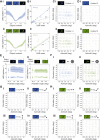Generating spatiotemporal patterns of linearly polarised light at high frame rates for insect vision research
- PMID: 35708202
- PMCID: PMC9339910
- DOI: 10.1242/jeb.244087
Generating spatiotemporal patterns of linearly polarised light at high frame rates for insect vision research
Abstract
Polarisation vision is commonplace among invertebrates; however, most experiments focus on determining behavioural and/or neurophysiological responses to static polarised light sources rather than moving patterns of polarised light. To address the latter, we designed a polarisation stimulation device based on superimposing polarised and non-polarised images from two projectors, which can display moving patterns at frame rates exceeding invertebrate flicker fusion frequencies. A linear polariser fitted to one projector enables moving patterns of polarised light to be displayed, whilst the other projector contributes arbitrary intensities of non-polarised light to yield moving patterns with a defined polarisation and intensity contrast. To test the device, we measured receptive fields of polarisation-sensitive Argynnis paphia butterfly photoreceptors for both non-polarised and polarised light. We then measured local motion sensitivities of the optic flow-sensitive lobula plate tangential cell H1 in Calliphora vicina blowflies under both polarised and non-polarised light, finding no polarisation sensitivity in this neuron.
Keywords: Electrophysiology; Neuroethology; Neuroscience; Polarisation vision.
© 2022. Published by The Company of Biologists Ltd.
Conflict of interest statement
Competing interests The authors declare no competing or financial interests.
Figures



Similar articles
-
High e-vector acuity in the polarisation vision system of the fiddler crab Uca vomeris.J Exp Biol. 2012 Jun 15;215(Pt 12):2128-34. doi: 10.1242/jeb.068544. J Exp Biol. 2012. PMID: 22623201
-
Behavioural evidence for polarisation vision in stomatopods reveals a potential channel for communication.Curr Biol. 1999 Jul 15;9(14):755-8. doi: 10.1016/s0960-9822(99)80336-4. Curr Biol. 1999. PMID: 10421580
-
Polarisation-dependent colour vision in Papilio butterflies.J Exp Biol. 2001 Jul;204(Pt 14):2469-80. doi: 10.1242/jeb.204.14.2469. J Exp Biol. 2001. PMID: 11511662
-
Polarisation signals: a new currency for communication.J Exp Biol. 2019 Feb 7;222(Pt 3):jeb134213. doi: 10.1242/jeb.134213. J Exp Biol. 2019. PMID: 30733259 Review.
-
Polarisation vision: overcoming challenges of working with a property of light we barely see.Naturwissenschaften. 2018 Mar 27;105(3-4):27. doi: 10.1007/s00114-018-1551-3. Naturwissenschaften. 2018. PMID: 29589169 Free PMC article. Review.
Cited by
-
An open platform for visual stimulation of insects.PLoS One. 2024 Apr 18;19(4):e0301999. doi: 10.1371/journal.pone.0301999. eCollection 2024. PLoS One. 2024. PMID: 38635686 Free PMC article.
-
Uncertainty minimization and pattern recognition in Volvox carteri and V. aureus.J R Soc Interface. 2025 Feb;22(223):20240645. doi: 10.1098/rsif.2024.0645. Epub 2025 Feb 26. J R Soc Interface. 2025. PMID: 39999882
References
-
- Bandai, K., Arikawa, K. and Eguchi, E. (1992). Localization of spectral receptors in the ommatidium of butterfly compound eye determined by polarization sensitivity. J. Comp. Physiol. A 171, 289-297. 10.1007/BF00223959 - DOI
-
- Blum, M. and Labhart, T. (2000). Photoreceptor visual fields, ommatidial array, and receptor axon projections in the polarisation-sensitive dorsal rim area of the cricket compound eye. J. Comp. Physiol. A Sensory, Neural Behav. Physiol. 186, 119-128. - PubMed
Publication types
MeSH terms
Grants and funding
LinkOut - more resources
Full Text Sources

